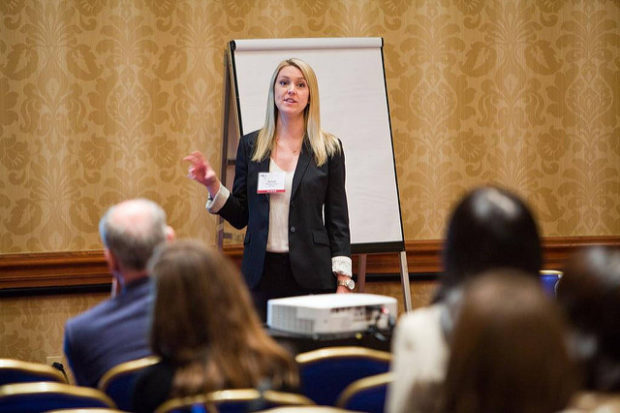Know Your Audience: The Key to Actionable and Effective Communication
For many of us, going to work means going to meetings. We work in teams or work with clients, and that means we need to communicate ideas, convey information, make recommendations, and persuade.
Our meetings might not always look the same: sometimes, you’re standing next to a PowerPoint projected on a screen in a conference room, and sometimes you’re chatting about an issue informally on Zoom. Sometimes there are dozens of pairs of eyes and ears on you, and sometimes it’s just one person. Whatever the format, there’s a common denominator: it’s not just the content that matters; it also needs to be communicated effectively.
Imagine you work as a senior demand analyst for a national coffee shop chain; your job is to recommend a solution to improve forecasting and reduce food waste. You’ve come up with a brilliant idea to save sixteen metric tons of scones each year; you just need some stakeholder buy-in. In theory, a meeting should be the most efficient means to that goal. You provide information; your stakeholders ask a question or two, and a decision is made. Easy. Done.
Of course, nothing is ever that easy. The finance director seems to think that your calculations include all baked goods, even though muffins are clearly out of scope, and the marketing manager keeps checking her phone while you’re explaining your research methodology.
Even if this isn’t exactly your story, you’ve probably experienced something similar. Meetings beget meetings; each question answered leads to more questions asked. It’s anything but efficient. You might know your stuff and be great at your job, but your audience just doesn’t seem to get it. How can you communicate more effectively at work?
Know your audience
It’s not enough to know your stuff – you also need to know your audience.
The idea is simple: The way you communicate should be tailored to the person or group you’re communicating with. You wouldn’t use the same style to ask your boss for a raise as you would when asking a barista for extra foam; you’d use different wording, you’d go into different levels of detail, and you’d provide varying degrees of well-reasoned arguments. Your audience should dictate just about every choice you make when it comes to crafting your message.
“Knowing your audience” is a big topic, however, so let’s narrow it down a bit. There are a few sub-bullets under “knowing your audience” that will help you communicate successfully and get the most out of your meetings: 1) know their baseline, 2) know their agenda, and 3) get to know them.

Know their baseline
First of all, know your audience’s baseline. Remember your Save The Scones campaign? Before you open up PowerPoint and start recording every bit of knowledge that you have on the subject, ask yourself a question about the other people on the Outlook invite: how much do they already know about the problem you’re presenting?
If the meeting’s outcome depends on everyone knowing the same facts, you need to provide those facts so that everyone has the same foundation of information to draw upon when they make a decision. The marketing manager might not know that the product margins are lower on blackberry scones than brown-sugar-cinnamon. The finance director might not know that environmental concerns rank highly with your primary demographic.
At the same time, though, if your audience already knows what they need to know, you don’t want to waste their time by going over it again. Even worse – you could come off as condescending: Now, I know you both have MBAs from Wharton, but ‘ROI’ is an acronym that stands for Return on Investment, and it’s typically calculated by….
Your audience’s knowledge will dictate the level of detail you go into – but how can you figure out how much they know? Often, it’s obvious. If you’re reporting your progress on an ongoing project to the project manager in a weekly standup, you can assume she has a pretty clear idea of what’s going on. If you’re presenting a pitch to a brand-new client team, on the other hand, you can assume they will need a bit of background. In situations where it’s not clear what everyone’s baseline is, the best course of action is simply to ask.
Come armed with information in case it’s necessary, but gloss over it if your audience already knows what they need to know to make a decision. Be ready and willing to tailor your content to make the meeting as efficient and effective as possible.
Know their agenda
Another element of knowing your audience is knowing their agenda. Once you’ve figured out what they already know, you should ask yourself how much they want to know.
Are your stakeholders just looking for a recommended course of action? If so, you don’t need to give them the entire methodology or tell them every single step you took to arrive at your conclusion. Sometimes they just want the top-down message, the ‘So What’, the tl;dr, one-sentence result; the finance director wants the bottom line.
Maybe, though, it’s a brainstorming session on an iterative project, and your colleagues want to know every detail. They want to hear the avenues you’ve explored – both what worked and didn’t work – and tell you what they’ve tried, so you can figure out the next best step. Or maybe the marketing manager wants to highlight your waste-reduction efforts in a behind-the-scenes Instagram series.
Each of these cases requires a different type of communication. Knowing your audience means knowing their agenda, and a solid knowledge of the agenda is essential for any successful meeting. Recognize what they’re looking for, and then tailor your story: is this a case for “Once Upon a Time…” all the way to “The End”, or is it better to start with “And they all lived happily ever after?”

Know them
We’ve talked about knowing your audience’s baseline and agenda, but the most importantly – get to know them.
Work is not a series of one-off transactions. Most of our meetings are with people we work with regularly, so take the time to build relationships. Ask people about themselves. Be interested. Read Dale Carnegie, make friends, and influence people.
The more you talk to people, the more you’ll learn, and the more you’ll come to understand their baselines and agendas as they relate to different topics: The finance director’s name is Natalie, and when she’s not measuring ROI, she runs marathons and a side-business; she’s constantly busy and hates wasting time. The marketing manager’s name is Ludo, and he keeps bees in his backyard; he loves what you’re doing to reduce food waste and wants your opinion on a program to get used coffee grounds into the hands of urban gardeners.
Make it a point to regularly initiate hallway conversations, cubicle visits, or five-minute Slack Huddles; not only can they help you get to know your audience, they can also prevent a lot of meetings from happening – and the most efficient meeting is the one that doesn’t get scheduled in the first place.
Success!
Meetings aren’t going away anytime soon, so we might as well get good at them. The best way to make your meetings more successful is to get to know your audience. If you know their baseline and their agenda, you can give them all the information they need to make a decision – and not a bullet-point more. That right there will make meetings more efficient and effective, and thus less frustrating, leaving you more time to get to really know your colleagues.
This guest post was authored by Megan Preston Meyer

Throughout the course of Megan’s career, she analyzed piles of data for numerous companies across the globe to create informed and data-driven decisions that helped optimize supply chains, streamline processes, and unlock millions of dollars of value. However, though fruitful, Megan decided to leave her job of examining numbers, creating reports, and spending too much time with Excel, and tell the stories of these businesses in a different way.
Megan now coaches and speaks about professional communication, and writes the Supply Jane and Fifo series – picture books for children about supply chain management. By teaching kids business and entrepreneurship early in life in a fun and entertaining way, they learn: problem solving, creativity, critical thinking, and many more skills.


